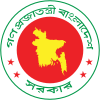Bangladesh Government
| Bengali: গণপ্রজাতন্ত্রী বাংলাদেশ সরকার | |

|
|
| Formation | 17 April 1971 (1st Government) |
|---|---|
| Constitution |
|
| Jurisdiction | Bengali Republic |
| Website | www |
| Legislative branch | |
| Legislature |
|
| Meeting place | Jatiya Sangsad Bhaban |
| Executive branch | |
| Leader | Prime Minister |
| Appointer | President of the Republic |
| Headquarters | Bangladesh Secretariat |
| Main organ |
|
| Departments | 58 Ministries |
| Judicial branch | |
| Court |
|
| Seat | Ramna Thana, Dhaka |
The Government of Bangladesh (Bengali: বাংলাদেশ সরকার Bangladesh Sôrkar GOB) is led by the Prime Minister, who selects all the remaining Ministers. The Prime Minister and the other most senior Ministers belong to the supreme decision-making committee, known as the Cabinet. The Government has three branches; the Executive branch, the Legislative branch and the Judicial branch.
The current Prime Minister is Sheikh Hasina, leader of the Bangladesh Awami League, who was appointed by the President on 6 January 2009 following the General Election on 29 December 2008. Bangladesh Awami League led by her, and its Grand Alliance (a total of 14 parties) won the two-thirds majority numerically the party controls 230 seats out of 299.
The President is the Head of State, a largely ceremonial post. The real power is held by the Prime Minister, who is the head of government. The president is elected by the legislature every five years and has normally limited powers that are substantially expanded during the tenure of a caretaker government, mainly in controlling the transition to a new government. Bangladesh has instituted a unique system of transfer of power; at the end of the tenure of the government, power is handed over to members of a civil society for three months, who run the general elections and transfer the power to elected representatives. This system was first practised in 1991 and adopted to the constitution in 1996.
As head of the state, the president can grant pardon to a man sentenced to death penalty or lessen the punishment. In some cases, it also performs some legislative and judicial functions.
The prime minister is ceremonially appointed by the president, commanding the confidence of the majority of the MPs. The cabinet is composed of ministers selected by the prime minister and appointed by the president.
...
Wikipedia
